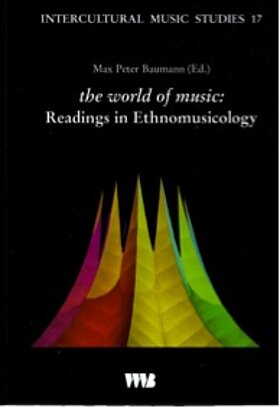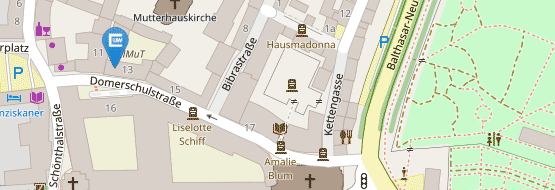IMS vol. 17
IMS vol. 17

Max Peter Baumann, ed.:
the world of music: Readings in Ethnomusicology (INTERCULTURAL MUSIC STUDIES vol. 17, ed. by Max Peter Baumann. A Series of the Department of Ethnomusicology, Institute for Music Research, Julius-Maximilian University of Würzburg).
VWB—Verlag für Wissenschaft und Bildung. Berlin 2012. – 767 pp. ISBN 978-3-86135-648-6.
Abstract
This volume brings together a collection of 33 articles which have been published within the last 15 years in the journal the world of music. The original articles appeared as separate contributions to 45 different topical issues of the journal. These reprints reflect a variety of ethnomusicological themes, methods, perspectives and viewpoints. The contributions portray a multifaceted panorama of ethnomusicological research and interest in questions related to music history, musical instruments, genres, and styles in regional and/or national contexts as well as in the creative tension of globalization and transculturalization. Utilizing distinct approaches and addressing a range of different subjects, the authors discuss a variety of topics with reference to the development of particular music traditions—traditions that are re-constructed, imagined, revived or transformed. The contributions show a broad range of interests in music and music developments in continuity, preservation, and intangible cultural heritage. The fields of inquiry range from musical meaning to musical listening, from the dynamic flow of local to those of global processes. Musicians, artifacts, performance practices, music and gender, biographies of musicians, ritual and drama enrich the topics, most of which are based on original field research, observation, and interpretation. All of these contributions are simultaneously involved in debates of selected theoretical issues referring either to the past, present or future of particular music traditions.
The construction and reconstruction of musical knowledge and experience presented in this volume encompasses case studies related to musical instruments such as sitar (India), didjeridu (Australia), shakuhachi, taiko (Japan), gamelan and wayang kulit banjar (Java), North American flute, jenbe (Mali), mbira (Zimbabwe), as well as genres such as kwaito (South Africa/Black Atlantic), kwaya (Tanzania), bhangra (U. K.), gypsy music (Croatia), tíguera and merengue (Dominican Republic), pansori and p’ungmul (South Korea). All of the case studies also point, amongst other things, to intercultural dynamics and to interrelations of local roots and global-oriented developing processes. The intercultural processes described in these articles are analyzed, with reference to historical and methodological factors, as forms of acculturation, hybridization or transculturation—and also according to regional, global or mass-mediated impact. The cultural dynamics of constructing and de-constructing musical identities are discussed in relation to discourses of hegemony, differentiation, de-territorialization of local traditions and economic pressure from the outside. The accelerating velocity of musical change is revealed in discussions of transmigration, festivals, and tourism and its increasing intercultural patterns. Locating and inventing traditions, revival, revitalization, and imagined the worlds of music, as well as social and political interactions, are examined in the structural context of music performance, of hearing and listening, and of understanding and judging cultural values. Musicians as well as scholars take position, directly or indirectly, on music related discourses which refer to the past (as music-societal memory), to the present (in the struggle for acceptance and success) and to the future (in imagining a “better world”).
Between analytical empiricism, hermeneutics, and spirituality, between religion, economy and ecology, and between politics, sustainability and democratic under-standing, the steady flow of “thick description” (Clifford Geertz) runs through each of these articles. They bear eloquent witness to the variety of ethnomusicological subjects on the one hand and to methodical-methodological plurality on the other. To this effect, the present anthology of reprinted articles may serve as a general Reader in Ethnomusicology to provide a means of looking back on a rapidly changing world where the results of field work studies—once devoted to the present—also increasingly transform into the building blocks of tomorrow’s historiography.
Contents
Max Peter Baumann: “Introduction,” 9-11.
1. Aspects of Music History: Archaeology, Iconography, and Transcultural Interest
Arnd Adje Both: “Aztec Music Culture,” 14-28.
Gerald Groemer: “The Rise of ‘Japanese Music’,” 29-53.
Bonnie C. Wade: “Performing the Drone in Hindustani Classical Music: What Mughal Paintings Show Us to Hear,” 54-68.
Bruno Deschênes: “The Interest of Westerners in Non-Western Music,” 69-79.
2. Musical Instruments: Between Re-contextualization, Imagination, and Modernity
Karl Neuenfeldt: “Good Vibrations? The ‘Curious’ Cases of the Didjeridu in Spectacle and Therapy in Australia,” 82-103.
Toru Seyama: “The Re-contextualization of the Shakuhachi (Syakuhati) and its Music from Traditional/Classical into Modern/Popular,” 104-17.
Paula Conlon: “The Native American Flute: Convergence and Collaboration as Exemplified by R. Carlos Nakai,” 118-31.
3. Musical Instruments: Beyond the Local and the Global
Rainer Polak: “A Musical Instrument Travels Around the World: Jenbe Playing in Bamako, West Africa, and Beyond,” 134-70.
Thomas Turino: “The Mbira, Worldbeat, and the International Imagination,” 171-92.
Linda Fujie: “Japanese Taiko Drumming in International Performance: Converging Musical Ideas in the Search for Success on Stage,” 193-201.
4. Sounding Voices: Identity, Spirituality, and Cultural Inheritance
Gregory Barz: “Soundscapes of Disaffection and Spirituality in Tanzanian Kwaya Music,” 204-28.
Laura Leante: “Shaping Diasporic Sounds: Identity as Meaning in Bhangra,” 229-52.
Dan Bendrups: “Easter Island Music and the Voice of Kiko Pate: A Biographical History of Sound Recording,” 253-68.
5. Inventing Traditions: Revival, Music Festivals, and Transculturalization
Timothy J. Cooley: “Folk Festivals as Modern Ritual in the Polish Tatra Mountains,” 270-93.
Max Peter Baumann: “Festivals, Musical Actors, and Mental Constructs in the Process of Globalization,” 294-313.
Owe Ronström: “Revival Reconsidered,” 314-29.
6. Music, Gender, and the Individual
Jonathan P. J. Stock: “Toward an Ethnomusicology of the Individual, or Biographical Writing in Ethnomusicology,” 332-46.
Regula Burckhardt Qureshi: “In Search of Begum Akthar: Patriarchy, Poetry, and Twentieth-century Music,” 347-86.
Beverley Diamond: “Native American Contemporary Music: The Women,” 387-414.
7. Ritual and Drama: Observation, Interpretation, and Reconstruction
Regine Allgayer-Kaufmann: “From the Innocent to the Exploring Eye: Transcription on the Defensive,” 416-31.
Martina Claus-Bachmann: “Kuveni, or the Curse of a Women as a Flashpoint for Music-oriented (Re-)Constructions,” 432-52.
Tiago de Oliveira Pinto: “Healing Process as Musical Drama: The Ebó Ceremony in the Bahian Candomblé of Brazil,” 453-73.
8. Meaning, Style, Genre, and Change
Margaret Kartomi: “Meaning, Style, and Change in Gamalan and Wayang Kulit Banjar Since Their Transplantation from Hindu-Buddhist Java to South Kalimantan,” 476-514.
Sonjah Stanley Niaah: “A Common Space: Dancehall, Kwaito, and the Mapping of New World Music and Performance,” 515-530.
Sydney Hutchinson: “Becoming the Tíguera: The Female Accordionist in Dominican Merengue Típico,” 531-50.
9. Listening, Hearing, and Understanding
Jean During: “Hearing and Understanding in the Islamic Gnosis,” 552-62.
Carl Gombrich: “Expressions of Inexpressible Truths: Attempts at Descriptions of Mystical and Musical Experiences,” 563-79.
Ben Brinner: “Cognitive and Interpersonal Dimensions of Listening in Javanese Gamelan Performance,” 580-95.
Christian Utz: “Listening Attentatively to Cultural Fragmentation: Tradition and Composition in Works by East Asian Composers,” 596-626.
10. Music, Politics, Ecology, and Democracy
Svanibor Pettan: “Gypsies, Music, and Politics in the Balkans: A Case Study from Kosovo,” 628-57.
Chan E. Park: “Poetics and Politics of Korean Oral Tradition in a Cross-cultural Context,” 658-669.
Nathan Hesselink: “Taking Culture Seriously: Democratic Music and Its Transformative Potential in South Korea,” 670-701.
Jeff Todd Titon: “Music and Sustainability: An Ecological Viewpoint,” 702-20.
11. Appendix
Acknowledgements, 722-23.
About the Authors, 724-31.
Index, 732-67.





